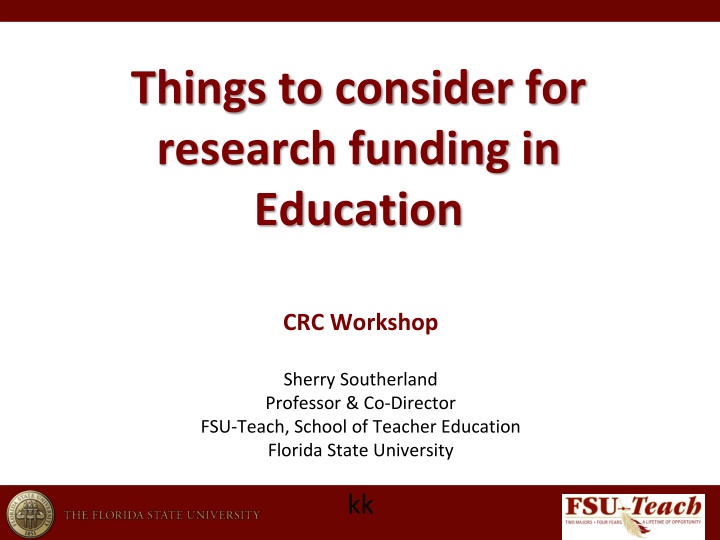
Strategies for Securing Research Funding in Education: Insights from Sherry Southerland
Explore expert advice from Sherry Southerland on obtaining research funding in education. Learn about leveraging external funding, initiating projects, engaging partners, and crafting compelling proposals to maximize success in securing funding for educational research.
Download Presentation

Please find below an Image/Link to download the presentation.
The content on the website is provided AS IS for your information and personal use only. It may not be sold, licensed, or shared on other websites without obtaining consent from the author. If you encounter any issues during the download, it is possible that the publisher has removed the file from their server.
You are allowed to download the files provided on this website for personal or commercial use, subject to the condition that they are used lawfully. All files are the property of their respective owners.
The content on the website is provided AS IS for your information and personal use only. It may not be sold, licensed, or shared on other websites without obtaining consent from the author.
E N D
Presentation Transcript
Things to consider for research funding in Education CRC Workshop Sherry Southerland Professor & Co-Director FSU-Teach, School of Teacher Education Florida State University kk
External Funding: Pro & Con How to minimize the con s (investment of time, energy, effort ,focus, good will, attention .) and maximize the pro s (TIME, funding for research, equipment, living wages for graduate students, travel)
Ways to Begin Begin with your own ideas lines of inquiry from your own research. Begin now to conceptualize possible project(s), well in advance. Do not be driven by them most recent call for proposals.
Ways to continue Begin speaking with interested/capable partners (here and elsewhere). Continue to mold the questions and possible methods. Then begin looking for possible funding opportunities.
So youve found an possible funder, now what? Read the RFP Not once or twice, but three times. Take notes. The RFP will help you identify: the needs of the agency; the scope, timeline, and size of the projects to be funded; the procedures and guidelines on submissions. Create a list of items you need to submit. Keep a running list of questions. Call the program officer.
Begin Building the Proposal 1. Assemble a competent team and roles - interdisciplinary and multi- institutional if possible suited to the funder and in line with teams that have been funded previously. 2. Work with your team to create a proposal strategy, begin contacting schools and visit with administrators. 3. Survey the terrain - know what s been done what was funded and what wasn t. 4.Call the program officer and run your idea by him/her; arrange a visit if possible. 5.Notify sponsored research and identify the representative who will process your proposal.
Continuing the Proposal 1. Refine the proposed program, working closely with your team and sponsored research to determine what can and cannot be supported by the grant. 2. Create a budget that closely matches and supports the proposed program. Budget details matter to reviewers. Look at earlier budgets to see the possibilities. (Run budget draft by sponsored research.) 3. Write the introduction to the narrative persuasively, carefully explaining makes this project important to others and the theory of action for the program.
A Few Hints for Writing Persuasive writing with an emphasis on your plan, how it will address the needs, and how will you get it done. Follow the guidelines on the formatting and setup. Proposals can be denied if they do not follow procedures. Build in internal and external evaluation components (whenever possible). The proposal should be easy to understand by anyone and not necessarily someone from your field. Assume total ignorance on the part of the reviewer. Provide the simplest conceptual background. Use no abbreviations or acronyms without definition. Do not force the reviewer to hunt through the application for information. Use diagrams to illustrate concepts.
So, you think youre done 1. Read the entire application, and check to be sure that each aspect of the RFP is addressed. 2. Obtain feedback on your draft from experienced grant writers the flow and details are important.
10 characteristics of solid proposals (Al Otaiba, 2008) : 1. Winning proposals have clearly defined needs and describe how those needs were identified. 2. Winning proposals describe solutions. 3. Winning proposals present the material in a logical manner. 4. Winning proposals are written in positive terms. 5. Winning proposals do not overuse jargon. 6. Winning proposals present detailed budgets that match the proposed program. 7. Winning proposals give something back. What is it? 8. Winning proposals follow all the guidelines specified in the RFP. 9. Winning proposals are professional in appearance. 10.Winning proposals are complete.
Be sure to leave time 1. From the day the RFP appears, work backward to create a timeline of the work. 2. Be sure to leave time for signatures and approvals and uploading into submission systems. Check out your department s and college s time frames at the very beginning of the process.
Realize that if at first you dont succeed 1. Look closely at your reviews. 2. Compare your project to those funded. Make this an item for discussion at professional meetings. 3. Speak to your program officer about areas for improvement. 4. Offer to help review proposals for the agency. ******************* 5. Grants get better every time and the writing is useful for other work that you do.
